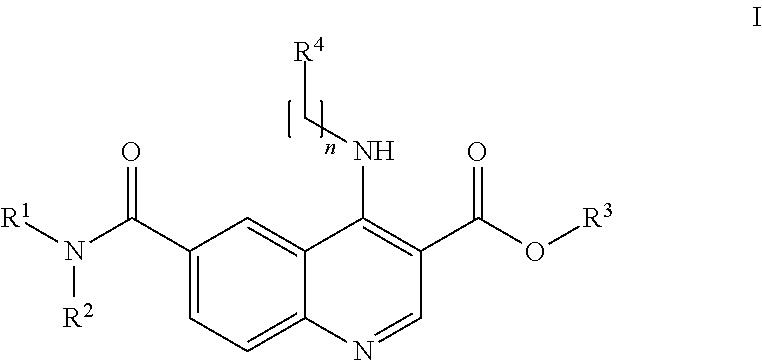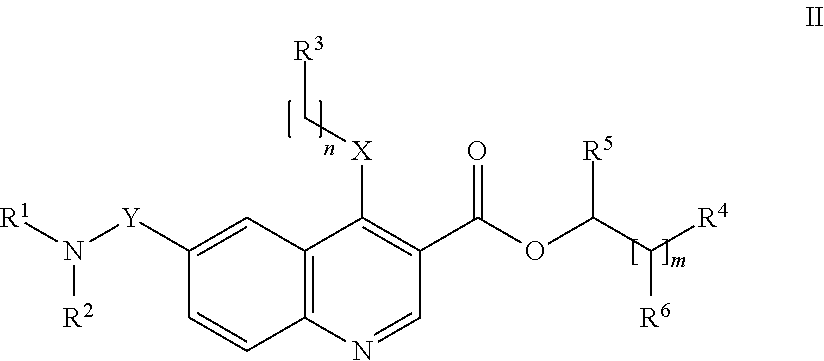Quinoline Compounds Which Are Anti-Angiogenic Integrin Alpha5 Beta1 Inhibitors for Use in the Treatment of Fibrosis or Fibrosis-Related Diseases
a technology of fibrosis and quinoline compounds, applied in the field of new medical therapy, can solve the problems of affecting the survival rate of patients, and affecting and achieves the effects of fibrosis-related diseases, reducing the risk of fibrosis, and reducing the survival rate of patients
- Summary
- Abstract
- Description
- Claims
- Application Information
AI Technical Summary
Benefits of technology
Problems solved by technology
Method used
Image
Examples
examples
Preparation of 4-[(4-Methoxyphenyl)amino]-6-(methylcarbamoyl)quinoline-3-carboxylic acid (Compound I-4 Above) hydrochloride
[0192]The hydrochloride salt of the compound 4-[(4-methoxyphenyl)amino]-6-(methylcarbamoyl)quinoline-3-carboxylic acid (compound I-4 above, prepared as disclosed in Example 4 of WO 2009 / 063070) was obtained from Ethyl 6-(methylcarbamoyl)-4-[(4-methoxylphenyl)amino]quinoline-3-carboxylate hydrochloride which was obtained as described in Example 3 of WO 2009 / 063070.
[0193]To a solution of ethyl 6-(methylcarbamoyl)-4-[(4-methoxylphenyl)amino]quinoline-3-carboxylate hydrochloride (100.0 g, 0.2636 mol, 1.0 equiv.) in THF (4.0 L) was added aqueous 1N NaOH solution (1.320 L, 52.8 g, 1.3 mol, 5.0 equiv.) at room temperature. The clear red solution was heated to 50° C. with constant stirring for 3 h. The reaction was monitored with TLC (10% MeOH in CHCl3, Rf: 0.1). The reaction mixture was allowed to attain room temperature and diluted with H2O (5.0 L). Two layers were fo...
PUM
 Login to View More
Login to View More Abstract
Description
Claims
Application Information
 Login to View More
Login to View More - R&D
- Intellectual Property
- Life Sciences
- Materials
- Tech Scout
- Unparalleled Data Quality
- Higher Quality Content
- 60% Fewer Hallucinations
Browse by: Latest US Patents, China's latest patents, Technical Efficacy Thesaurus, Application Domain, Technology Topic, Popular Technical Reports.
© 2025 PatSnap. All rights reserved.Legal|Privacy policy|Modern Slavery Act Transparency Statement|Sitemap|About US| Contact US: help@patsnap.com



